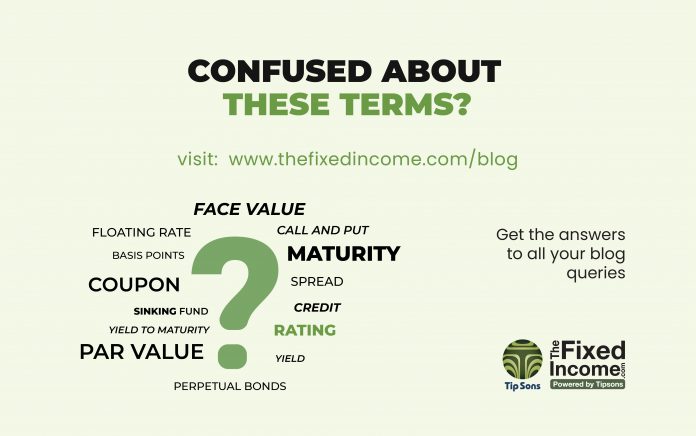Understanding Bond Terminology
The little club of us fixed income market players, like just about every other profession, has built-in some jargon to make us seem smart to the uninitiated. Besides, jargon are simple terms that make the bond market a little walk in the park, rather than traversing a complex maze. Understanding the terminology will help us know more of the products on offer, making our investments better rooted in knowledge, reducing the risks.
Key Terms in Bond Market
Par value or Face value is the basic denomination of the bond. This is the amount on which the interest on the bond is calculated. It is also, normally, the amount of principal of the bond that is returned to the investor when the bond has achieved its full lifetime. All long-term government securities have an Rs. 100 par value, short-term Treasury Bills are Rs. 1,000 each. Corporate bonds par values do not have a set rule.
A Coupon is the percentage of interest that a bond pays in a year. This is not rigid, with exceptions being the regularity of compounding, which could be monthly, quarterly, half-yearly, or annually. The coupon could also vary regularly in the case of a floating rate bond.
Floating rate is a familiar concept to home loan borrowers over the last couple of decades. Also called “Adjustable rate”, “Floaters” are bonds whose interest rate changes at pre-fixed intervals, often each quarter, and are linked to a certain benchmark. A common benchmark in India is the rate of inflation linked to the consumer price index. Globally the London Interbank Offered Rate (LIBOR) is a common benchmark.
Basis point is used in the measure of the yield of a bond. A basis point, pronounced ‘beep’ by market players, written as bp(s) is one-hundredth of one percent. It matters to our returns!
Yield to maturity (YTM) is a measure of what returns a bond will give if held through its life.
Maturity is a point in time when the bond actually expires or ceases to exist. All bonds, with the exception of perpetual bonds, have a date on which the principal is repaid to the owner of the bond. The maturity proceeds are paid out entirely at a single point, called a bullet payment, or in installments.
Perpetual bonds are generally issued by banks and financial institutions as a part of their Tier-1 capital as prescribed under Basel 3 norms for the safety of their depositors and the financial system. While ‘perpetual’ means forever, these bonds are issued with a “call” that the issuer may exercise, which means to return the money to the investor. In India, perpetual bonds have an option to call, but not put, every 5 years.
Call and put are options that are linked to bonds similarly to their usage while dealing in the derivatives market for any financial product. These have a long history, going back about 2500 years to the Greeks. Call gives the issuer the right to return the money, put is the right of the bondholder to demand the return of the principal of the bond.
Credit rating is the certification by a qualified external agency of the ability of the borrower to repay the money borrowed. AAA is the highest rating, D indicates default. Government bonds are totally safe against their local borrowings.
Spread is the difference in interest or yield between a government bond and other rated bonds. Naturally, a bond with a lower rating comes with higher interest rates to compensate for the relatively higher risk the bond carries.
Sinking fund or amortization is the borrower setting aside money towards payment of interest and repayment of the bond. This may show as ‘Debenture Redemption Reserve’ in the balance sheet of the issuer.
We will look at certain other terminology when we specifically study them in the context of their impact on bond valuations.






















